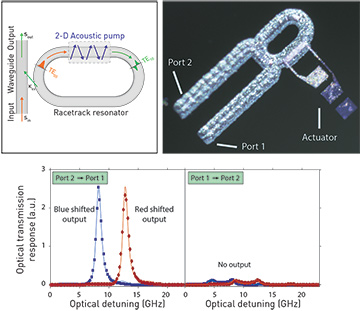 Top: Design and microscope photograph of acoustically pumped integrated aluminum nitride nanophotonic isolator. Bottom: The isolator provides a frequency-shifted output in one direction while blocking light in the opposite direction. [Enlarge figure]
Top: Design and microscope photograph of acoustically pumped integrated aluminum nitride nanophotonic isolator. Bottom: The isolator provides a frequency-shifted output in one direction while blocking light in the opposite direction. [Enlarge figure]
The reciprocity of electromagnetic-wave propagation in linear time-invariant media arises from the fundamental time-reversal symmetry of Maxwell’s equations. In a nonlinear or non-time-invariant medium, however, this time-reversal symmetry need not be honored. This principle allows the production of optical isolators and circulators, which are indispensable for almost all optical systems, and which commonly rely on the magneto-optical Faraday rotation effect to achieve non-reciprocal functions.
Unfortunately, magneto-optical devices are not yet available in integrated photonics foundries, owing to several challenges: the necessary materials are not available; the Faraday rotation effect is very small for currently available materials, especially at VIS-IR wavelengths; and each operational wavelength band needs a different material. A non-reciprocal photonic technology that circumvented these constraints, and instead utilized common dielectrics having broadband transparency, would be transformative for integrated photonics.
Previously, researchers have shown that that the momentum selection rules intrinsic to Brillouin scattering—the photoelastic scattering of light from acoustic waves—can also be used to break time reversal symmetry.1 Variations on this principle have since underlain a variety of optomechanics experiments with great success, but always using optical pumping to produce the non-reciprocity and with limited bandwidth in the kHz-to-MHz range.2,3 These are both fundamental and practical constraints.
This year, we demonstrated that all of these limitations can be overcome by simply inverting the roles of light and sound within a non-reciprocal optomechanical system.4 We fabricated a nanophotonic racetrack resonator in an aluminum-nitride-on-air platform, with a piezoelectric actuator co-integrated over a segment of the racetrack to produce the acoustic pump. The design of the propagating RF-driven acoustic wave includes a 2-D characteristic that simultaneously satisfies the unidirectional phase-matching requirement and breaks the orthogonality of optical modes of the resonator. The resulting isolator produced non-reciprocal conversion asymmetry of up to 15 dB, efficiency as high as 17 percent and, for the first time, bandwidth exceeding 1 GHz.
This type of non-reciprocal device can play an important role in emerging chip-scale atomic timekeeping, inertial navigation and gravimetry, in which magnet-induced Zeeman shifts and light shifts are extremely undesirable.5 More important, the operating wavelength and pumping of the non-reciprocal system are defined entirely lithographically, which ensures that this new fundamental principle can be rapidly adapted to other wavelengths.
Researchers
Donggyu Sohn, Seunghwi Kim and Gaurav Bahl, University of Illinois, Urbana-Champaign, Ill., USA
References
1. J. Kim et al., Nat. Phys. 11, 275 (2015).
2. K. Fang et al., Nat. Phys. 13, 465 (2017).
3. F. Ruesink et al., Nat. Commun. 7, 13662 (2016).
4. D.B. Sohn et al., Nat. Photon. 12, 91 (2018).
5. J. Kitching, Appl. Phys. Rev. 5, 031302 (2018).
